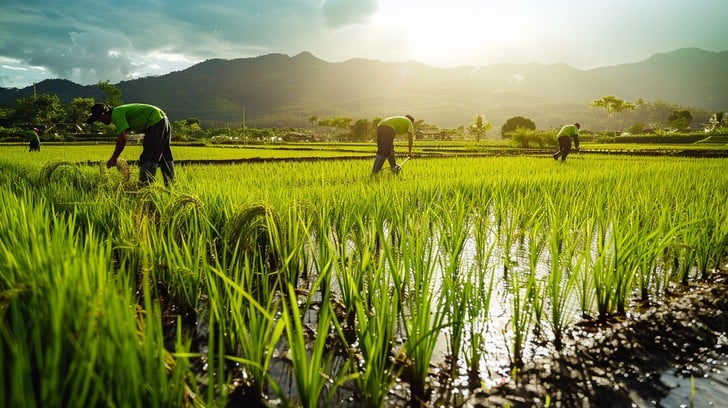The global rice market is at a critical juncture, experiencing heightened volatility as trade restrictions, cross-border sourcing disputes, and shifting consumer sensitivities come to the forefront. The imposition of India’s trade ban on Pakistani-origin goods after May 2025, alongside Europe-bound rerouting of Basmati rice, underscores the complex geopolitical landscape shaping rice flows. While Indian authorities deny involvement, evidence of Indian-linked subsidiaries sourcing over 14,300 tones from Pakistan in recent months complicates India’s exclusive claims over Basmati’s Geographical Indication. This situation exposes deep-rooted structural dependencies—Europe historically sources almost one-third of its annual Pakistani Basmati rice imports via such channels, representing over $2.5 billion in the last decade.
Policy moves like India’s Minimum Export Price (MEP) on Basmati last year led to a surge in Pakistani exports and showcased the market’s agility, but also its vulnerabilities. Meanwhile, the rise of pirated Indian varieties in Pakistani exports, and looming US tariff hikes on Indian rice, threaten to further fragment the traditional order. All these factors are swirling over a market already feeling downward price pressure amid steady harvests in Vietnam and mixed yield prospects in South Asia. As the second half of 2025 unfolds, market participants must brace for legal, economic, and weather-driven shocks.
Exclusive Offers on CMBroker

Rice
all golden, sella
FOB 1.00 €/kg
(from IN)

Rice
all steam, pr11
FOB 0.50 €/kg
(from IN)

Rice
al ısteam, sharbati
FOB 0.65 €/kg
(from IN)
📈 Prices at a Glance
| Type | Origin | Location | Delivery | Current Price (EUR/kg) |
Weekly Change (EUR/kg) |
Sentiment |
|---|---|---|---|---|---|---|
| All Golden Sella | IN | New Delhi | FOB | 1.05 | -0.01 | Neutral/Bearish |
| All Steam, PR11 | IN | New Delhi | FOB | 0.56 | -0.01 | Bearish |
| All Steam, Sharbati | IN | New Delhi | FOB | 0.71 | -0.01 | Bearish |
| All Steam, 1121 Steam | IN | New Delhi | FOB | 0.97 | -0.01 | Bearish |
| White, Basmati (Organic) | IN | New Delhi | FOB | 1.91 | -0.01 | Stable |
| Long White 5% | VN | Hanoi | FOB | 0.62 | -0.01 | Neutral/Bearish |
| Jasmine | VN | Hanoi | FOB | 0.64 | -0.01 | Neutral |
🌍 Supply & Demand
- India’s formal ban on Pakistani-origin imports since May 2025 is circumvented by subsidiaries and overseas-owned entities, signaling persistent demand in Europe and risk of gray market inflows.
- Pakistani Basmati exports, especially to the UK and Netherlands, jumped post-ban—potentially undermining India’s GI protection efforts in Europe.
- Despite regulatory hurdles, Europe and Middle East buyers maintain robust demand for Basmati, while African and Asian markets favor competitively priced long-grain varieties from Vietnam and Thailand.
- US market may see stronger inflows of Pakistani rice if new tariffs on Indian exports stick, shifting traditional supply lines.
- Vietnam continues to ship stable volumes with favorable weather outlook supporting output for the remainder of 2025.
📊 Market Fundamentals
- India and Pakistan jointly account for over 70% of world Basmati trade, with Vietnam and Thailand dominating the global non-Basmati segment.
- India’s 2024/25 rice crop expected at near-trend yields, though some northern states face rainfall shortfall. Pakistan’s Punjab area reported mixed field conditions but overall output holds steady on the decade average.
- Global ending stocks remain comfortable but uncertainty persists due to structural policy shifts and rising freight costs.
- Speculative positioning has receded after drastic price swings in 2023, but any escalation in India–Pakistan trade friction or adverse weather events could reinvigorate volatility.
⛅ Weather Outlook
- India: Monsoon recovery in July improved prospects for most major paddy-growing regions, but localized delays in Punjab and Haryana may cap top-end Basmati yields.
- Pakistan: Adequate irrigation and moderate temperatures support Basmati plantings in Sindh and Punjab, though scattered pest outbreaks reported. No major flood risks seen near-term.
- Vietnam/Thailand: Rice-belt regions experiencing timely rains with minimal stress, boding well for third-quarter harvests and export flows.
🌐 Production & Stocks: 2024/25 (Estimate)
| Country | Production (Mln t) | Exports (Mln t) | Ending Stocks (Mln t) |
|---|---|---|---|
| India | 131 | 22 | 37 |
| Pakistan | 9.6 | 4.2 | 1.2 |
| Vietnam | 28 | 7.8 | 4.0 |
| Thailand | 20.5 | 7.0 | 5.0 |
| China | 147 | 2.4 | 103 |
📌 Key Market Drivers
- India’s trade ban and enforcement actions vs. European Basmati imports from Pakistan.
- Europe’s regulatory stance on GI protection and response to illegal / unauthorized imports.
- US tariff escalation on Indian rice, possible switching of supply toward Pakistan and Southeast Asia.
- Stable Southeast Asian output and weak international freight rates are capping price rallies.
- Weather risks in the Indian subcontinent—late monsoon or pest emergencies could trigger upward price shocks.
📆 Trading Outlook & Recommendations
- Exporters: Diversify destinations; leverage thriving Middle East and African demand as Europe tightens GI enforcement on Basmati.
- Importers: Secure forward contracts with reputable suppliers; monitor regulatory changes in Europe and the US.
- Traders: Watch US policy for further tariff shifts; opportunistic buying possible if volatility increases due to policy headlines.
- End-Users/Food Industry: Maintain inventory buffers given ongoing legal and supply disruptions.
🔮 3-Day Regional Price Forecast (FOB New Delhi & Hanoi, EUR/kg)
| Type | Region | Day 1 | Day 2 | Day 3 | Bias |
|---|---|---|---|---|---|
| Basmati, Golden Sella | IN | 1.05 | 1.04 | 1.04 | Weakly Bearish |
| PR11 Steam | IN | 0.56 | 0.56 | 0.55 | Bearish |
| 1121 Steam | IN | 0.97 | 0.96 | 0.96 | Bearish |
| Long White 5% | VN | 0.62 | 0.62 | 0.62 | Stable/Neutral |
| Jasmine | VN | 0.64 | 0.64 | 0.64 | Stable |


